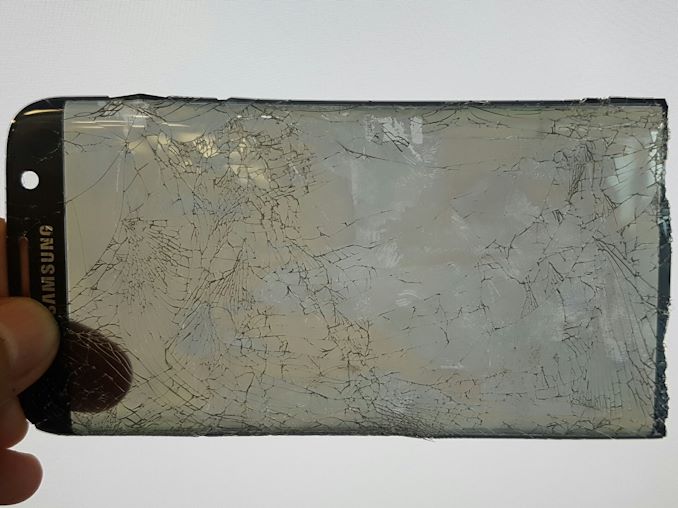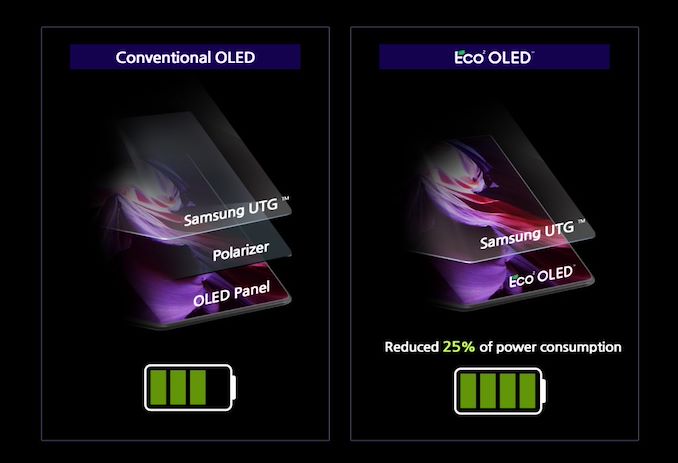Samsung Display Announces Polarizer-less OLED With 25% Less Power
by Andrei Frumusanu on August 16, 2021 12:01 PM EST- Posted in
- Mobile
- Smartphones
- OLED
- Samsung Display

Today Samsung Display Company (SDC) is announcing the introduction and mass production of a new generation of OLED panel called “Eco²OLED”. While the news here is rather short, it’s actually a massive technically undertaking and shift from past generation OLED panel technologies, as the new panel type is making due without the classical polarizer layer in-between the actual panel and cover glass.
In a traditional OLED panel, the actual panel itself is of a copper colour, which of course doesn’t work very well for displaying black. To create a reflective black, displays use polariser layers which block light from entering and reflecting off the display, only allowing light generated by the display itself to go through the glass.

Cover Glass and Polarizer on Galaxy S7
The problem with such layers is that they are of a reduced transmittance, and the polarizer itself is eating some of the light emitted by the panel. The above picture for example is the cover glass and polarizer of an old Galaxy S7, which appears notably darker than the lit background.
Samsung is explaining that they’ve managed to get rid of this polarizing layer, and are able to have non-reflective OLED panels which display as black. This is a major change in the display stack, and Samsung is quoting that they’re able to improve transmittance by a massive 33%, meaning 33% brighter screens, or at the same brightness, reduce power consumption by 25%.
These figures are massive, and should represent one of the largest jumps in power efficiency in OLEDs since their inception.
Samsung Display states that the Eco²OLED is already being used in Samsung Mobile’s Galaxy Z Fold3, meaning this should be the first phone to be able to take advantage of the technology. Along with this year’s widespread adoption of LTPO panels which massively improved power efficiency, this could signal a new large jump in smartphone power efficiency and help improve battery life of devices adopting the technology.











51 Comments
View All Comments
programmer_programmer - Thursday, August 19, 2021 - link
This sounds dangerous to one's eyes and anything else.GoldenBullet - Wednesday, September 1, 2021 - link
lolNextGen_Gamer - Monday, August 16, 2021 - link
I'm going to go ahead and guess that there is a really good chance that these will be used in Apple's upcoming iPhone 13 Pro series. The regular 13 would stick with the current-gen OLED panels, in order to keep profit margins up, while the 13 Pro models with their 120Hz refresh rate would benefit from these Eco²OLED panels increased battery efficiency.Wrs - Monday, August 16, 2021 - link
Very poor chance. They're only now starting mass production, can't ramp up that fast. Only needing to make screens for the low volume Z Fold 3 is manageable. The Pro model iPhones are another storyeek2121 - Wednesday, September 1, 2021 - link
The pro model iPhones aren't low volume. They account for a large portion of total iPhone sales. You won't see these displays in an iPhone 13.Low volume doesn't really exist for any iPhone to be honest...compared to the rest of the smartphone market.
GC2:CS - Monday, August 16, 2021 - link
Well oleds really went up since the iPhone X.It is a possibility that apple will get the best of the best but the next gen after 12 Pro is quite a high volume product so it might not be feasible.
I think that this might relate to the rumors of oled iPads (going to going to ahead). Just slaping a todays oled on an iPad would kill the battery or be much dimmer at that size. Not even mentioning that mini LED display iPad Pro what oled would compete with that ?
Thatsamdude - Monday, August 16, 2021 - link
Modern oleds are better than miniLED. MicroLED is best. Also apple doesnt make their OLEDs, Samsung does...caribbeanblue - Monday, August 16, 2021 - link
I don't think the original comment claimed that Apple made its own OLED displays, hence the "It is a possibiltiy that Apple will get the best of the best"? Also, do you know Apple's MiniLED panel has 1000 nits sustained 1600 nits peak brightness?Wereweeb - Tuesday, August 17, 2021 - link
"Muh more nits" is irrelevant when there are distracting artifacts all over dark screens. Mini"LED" is just a desperate attempt to keep LCD's competitive against OLED and the future Quantum dot / microLED technologies that are being developed.Wrs - Tuesday, August 17, 2021 - link
TBH the only distracting artifacts to me come from OLED burn. Nothing like seeing an extraneous blob or line while viewing a web page or smooth surface... That "blooming" of mini LED is only noticeable in white-on-black end credits and purposely generated test content. I never otherwise notice it in movie/news/desktop content on my iPad